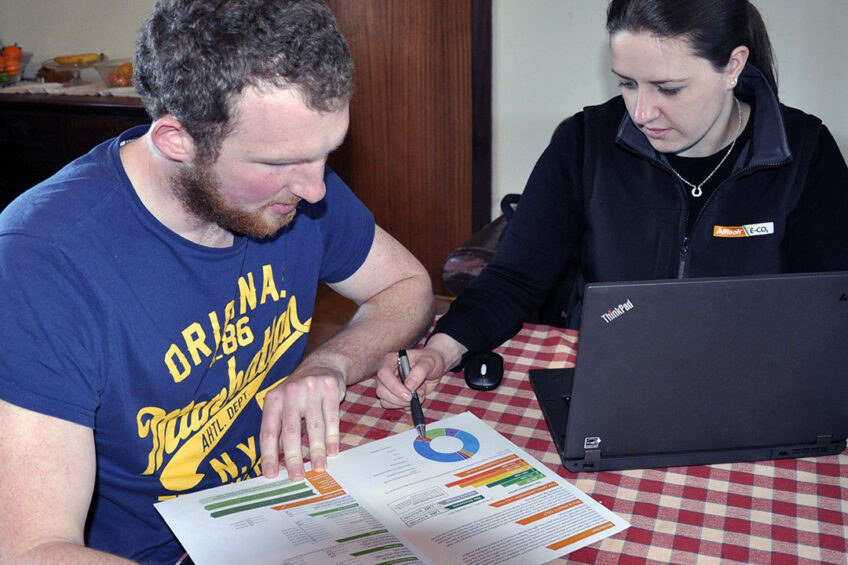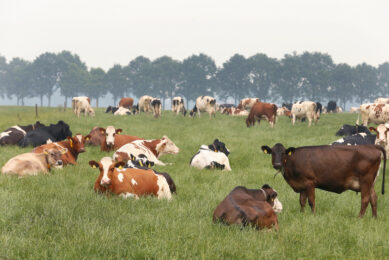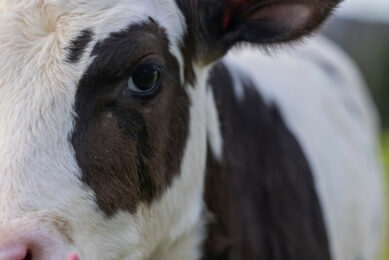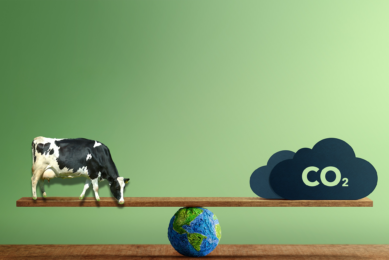Redefining efficiency: More milk, lower carbon footprint

Today’s media frenzy surrounding agriculture’s impact on climate change has highlighted, more than ever before, the need for agriculture to tell its side of the story. While there is no denying that livestock production inherently contributes to global greenhouse gas (GHG) emissions, cattle are not the primary drivers of climate change.
Nonetheless, as an industry we must accept that the agricultural sector has a role to play in taking positive action on a global issue. Feeding a growing population while also protecting the planet is a challenge that cannot be underestimated, and we must acknowledge that dairy and beef producers have made great strides in recent times. We simply need to look at the fact that global milk production increased by 60% in 20 years (IFCN, 2017), even though the dairy herd has been shrinking in the developed world. Such a positive trend has come about through improved efficiencies, which minimise the environmental impact while at the same time have the potential to improve farmers’ financial stability.

Life cycle analysis approach
Emissions from agriculture arise from both on- and off-farm processes. In order to successfully lower agriculture’s footprint, the industry must recognise that the problem is far greater than looking at individual GHGs in isolation. Owing to the dynamic nature of livestock production systems, solely concentrating on reducing emissions in one specific area of a production system — such as fertiliser application — may indirectly result in an increase elsewhere in the system. Strategies to mitigate emissions must consider the balance of emissions across the entire production system. A life cycle analysis approach is one way of doing that – by examining all inputs, processes and outputs of a system, from obtaining raw materials to products leaving the farm gate, we can get a true picture of a farm’s environmental footprint. A life cycle observation is all about efficiency at system level, and improving that efficiency also means more money for the farmer. Having conducted more than 9,000 farm assessments at Alltech E-CO2, we have seen that the most environmentally efficient farms are often the most profitable farms too.
Is methane’s impact short-lived?
Much of the conversation surrounding agriculture’s environmental impact focuses on methane emissions from ruminants, as they account for the largest share of the total emissions on-farm. Enteric emissions (methane from the rumen) account for up to 45% of a typical dairy or beef farm’s carbon footprint, while around 25% of emissions are typically derived from production and purchase of feed inputs (Alltech E-CO2, 2019). Nitrous oxide has a global warming potential 298 times greater than carbon dioxide, while methane’s potential is 25 times greater than carbon dioxide. Thus, although they only contribute around 11% of the total footprint, a shift in nitrous oxide emissions from applied fertilisers and animals’ deposition at pasture can make a significant impact on the life cycle. The impact of methane has been questioned by many due to its much shorter lifespan compared to other gasses. It is true that methane degrades in the atmosphere after 10–12 years; however, it does so into carbon dioxide. This resides in the upper atmosphere for potentially thousands of years before reaching equilibrium and cannot merely return within a short time to be taken up by crops and the biosphere. Therefore, a short-lived GHG does not necessarily equal a short-lived contribution to climate change. Fortunately, there are proven ways of successfully reducing methane intensity and, ultimately, a farm’s total carbon footprint.

The way forward
The agriculture industry has historically failed to establish a message that reducing emissions is not merely a tick-box exercise, but an opportunity to re-evaluate farm efficiency. Lowering a farm’s footprint may seem burdensome to producers, but there are many positive gains to be achieved along the way. Simply put, emissions are an indicator of waste, and reducing a farm’s footprint goes hand-in-hand with increasing farm efficiency. The first step for producers is identifying the farm’s carbon footprint and sources of emissions with an environmental assessment. It is important to investigate ways in which emissions can be reduced without compromising farm productivity. Finding a balance between the two is crucial for maintaining sustainability in the future.
Feeding programmes
Since the rumen is central to the ruminant life cycle, promoting efficiency through feeding programmes and ingredient selection is critical. Feeding rumen modifiers can directly reduce methane emissions by altering the biochemistry of the rumen and/or selectively inhibiting methane-producing microbes in the rumen. However, some available technologies that claim to reduce enteric methane emissions can have a negative impact on rumen bacteria and, ultimately, animal performance. There are currently too many questions over their real-world efficacy for such technologies to become mainstream. Programmes for reducing emissions and a farm’s carbon footprint via nutrition and feed should focus on the tried and trusted approach of providing feeds that are digestible and maximise animal production and efficiency.
Yea-Sacc from Alltech is a yeast culture that allows producers to increase productivity in dairy and beef herds while simultaneously lowering emission intensity. Yea-Sacc stimulates fibre-digesting and lactic acid-utilising bacteria, which optimises fibre digestion and nutrient utilisation with less potential energy being wasted to the environment. Backed by almost four decades of research with consistent performance responses, Yea-Sacc has been helping producers to address emissions since before it became acknowledged as a global problem.
Feeding programmes should also consider using sustainable ingredients. For example, soya bean meal and palm kernels carry a high carbon burden if not sourced from responsible production. With that, the sustainability of your production system is inherently tied to the sustainability of cultivation which could be up to thousands of miles away on another continent. Optigen from Alltech is a non-protein nitrogen source that can reduce the global warming potential of a diet by up to 17%. One tonne of Optigen can replace eight tonnes of soya and allows for more homegrown forages — which carry a low-carbon weight — to be utilised in the diet. Ultimately, a sustainable system is based on a foundation of good forage management. Speaking at Alltech’s European Technical Summit in Ireland earlier this year, Carolyn Opio from the FAO highlighted how ruminants have a low overall efficiency of nitrogen utilisation; between 70–95% of the nitrogen in diets is excreted in dung and urine. Accordingly, increasing the efficiency of rumen nitrogen capture, which can be achieved with Optigen, leads to less wasted nitrogen and greater benefit to producers and the environment.
A proven approach
It has been proven time and time again that higher-producing animals are more efficient and have a lower carbon footprint than their lower-producing counterparts in the same management system. Increasing animal production through nutrition, management and genetics decreases maintenance energy requirements, thereby increasing feed efficiency. This shift then resonates across the life cycle and up the supply chain, reducing the carbon footprint per unit of milk. In an Alltech study of 14,000 dairy cows on 58 farms across Europe, we saw that improving herd health and productivity significantly lowered farm carbon footprints. On average, we saw improved milk yield by one litre per cow per day, four fewer open days along with a reduction in several herd health issues, resulting in increased profitability of € 238 per cow per year. The carbon emissions savings from this year-long study, were equivalent to more than 2,000 fewer cars on the road and almost 550 fewer flights.
Aside from the animal, there are many more opportunities to improve efficiencies in production systems.
A life cycle analysis helps to visualise an entire system, identifying hot spots or areas for improvement. Assessments consider feed utilisation, fertiliser usage, housing, ventilation, water utilisation and energy use. These variables are interdependent in the livestock system, and drastic changes are not always required; incremental steps can make a significant contribution. Some practical solutions include improving manure management, forage management, anaerobic digestion, precision slurry utilisation and purchasing less nitrogen. Feed is the single greatest cost to the farm so must be treated as such by; minimising waste from stores, ensiled forages and at feedout. Adopting a strategy that considers the entire production system leads to accumulative gains across multiple areas and results in a more significant reduction in carbon footprint. These not only benefit the producer but will again resonate over the life cycle and the supply chain.
Producers have already made significant progress in lowering their footprint without compromising productivity, and we must continue to help them to go even further. This should not be seen as a burden to the producer or industry, but an opportunity to improve our production systems. Instead of focussing on improving one area (or one gas) by 100%, we — meaning all stakeholders in the supply chain — should ask ourselves, can we improve 100 things by just 1%? Ultimately, our message should be a common one: A more efficient production system is a more sustainable system, and leads to a more profitable farm.
Join 13,000+ subscribers
Subscribe to our newsletter to stay updated about all the need-to-know content in the dairy sector, two times a week.










